
Delémont is the capital of the Swiss canton of Jura. The city has approximately 12,000 inhabitants as of 2013.

Porrentruy is a Swiss municipality and seat of the district of the same name located in the canton of Jura.

The Basel city walls are a complex of walls surrounding the central part of the Swiss city of Basel, only partially preserved today. The first city wall was completed around 1080 under bishop Burkhard von Fenis. A newer wall was constructed around 1230, which is known as the Inner Wall. Its course was mostly identical to the Burkhard wall. In 1362 the construction of a larger wall complex began due to the city's expansion; it was completed in 1398, and is known as the Outer Wall. In 1859 the city's executives decided to raze the inner wall and gates to the ground. Three outer city gates and a short piece of the wall were saved from demolition and are being preserved as part of the city's heritage.

The Battle of Héricourt was fought on 13 November 1474 near Héricourt, Burgundy, as part of the Burgundian Wars. It resulted in victory for the Swiss Confederacy and its allies over the Burgundian State.

The Diocese of Sion is a Latin Catholic ecclesiastical territory in the canton of Valais, Switzerland. It is the oldest bishopric in the country and one of the oldest north of the Alps. The history of the Bishops of Sion, of the Abbey of St. Maurice of Valais as a whole are inextricably intertwined.
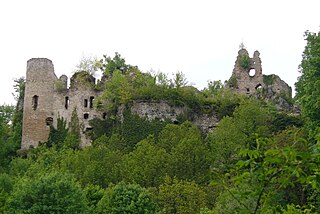
The Château de Morimont is a ruined castle in the Alsace region of France, in the commune of Oberlarg in the Haut-Rhin département. It is 40 km southwest of Mulhouse and 45 km west of the Swiss city of Basel.

Basel was a canton of Switzerland that was in existence between 1501 and 1833, when it was split into the two half-cantons of Basel-City and Basel-Country.

Basel Minster is a religious building in the Swiss city of Basel, originally a Catholic cathedral and today a Reformed Protestant church.

The Prince-Bishopric of Basel was an ecclesiastical principality within the Holy Roman Empire, ruled from 1032 by prince-bishops with their seat at Basel, and from 1528 until 1792 at Porrentruy, and thereafter at Schliengen. As an imperial estate, the prince-bishop had a seat and voting rights at the Imperial Diet. The final dissolution of the state occurred in 1803 as part of the German Mediatisation.
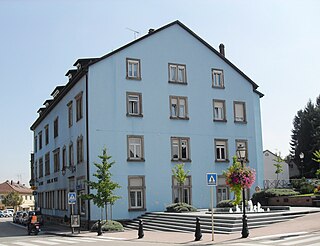
Hégenheim is a commune in the Haut-Rhin department in Alsace in north-eastern France. It is adjacent to the Swiss town of Allschwil, and is part of the Basel urban area.

The Münch were a Swiss knightly family in the city of Basel and its environs. The first mention of the family dates from 1154; it died out in 1759. In the thirteenth century it was, with the Schaler family, one the most influential families in Basel. From about the end of the fourteenth century members of the family took no further part in the political life of the city.

Basel-Münsterhügel is the site of an Iron Age fort or oppidum, known as Basel oppidum, constructed by the Gaulish Rauraci after the battle of Bibracte in 58 BC. It the site of Basel Minster, in the Swiss city of Basel.

Jakob Christoph Blarer von Wartensee was a Bishop of Basel and a leader in the Counter-Reformation in the region around Basel, in Switzerland.
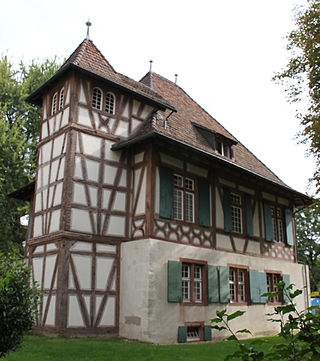
Gundeldingen Castle is a castle in the Gundeldingen neighborhood of the municipality of Basel of the Canton of Basel-Stadt in Switzerland. It is a Swiss heritage site of national significance. Originally four related castles, today parts of only two remain.
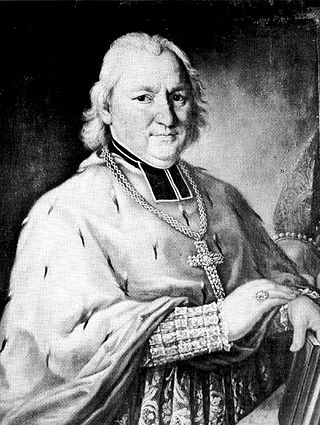
Franz Xaver Freiherr von Neveu (1749–1828) was the last Prince-Bishop of Basel, reigning from 1794 to 1803. After the Prince-Bishopric of Basel was mediatised to the Margraviate of Baden in 1803, Neveu remained Bishop of Basel, though without exercising temporal power, until his death in 1828.
The following is a timeline of the history of the city of Basel.

Inzlingen Castle, also Reichenstein Castle is a medieval castle surrounded by a moat situated in the village of Inzlingen. Inzlingen is located in the district of Lörrach, Baden-Württemberg, in the very south-west of Germany just at the Swiss border line near Basel. The origins of the castle cannot be clearly dated. The first written evidence dated 1511 – at this time already a possession of a relative of the barons Reich von Reichenstein. This noble family hold fiefdoms from the Prince-Bishopric of Basel, the Margraviate of Baden and the House of Habsburg. A Prince-bishop of Basel, six mayors of Basel and a principal of Basel University came from this noble family. In 1394 Margrave Rudolf III. enfeoffed Heinrich Reich von Reichenstein with the right for high justice regarding the village of Inzlingen and afterwards the family was in a position to acquire also a substantial landholding within this village and named themselves Lords of Inzlingen. A first major conversion of the castle dated 1563 to 1566. A copper engraving published 1625 shows the buildings at this time. Later the buildings were converted to a Baroque style and in about 1750 a Baroque interior followed.
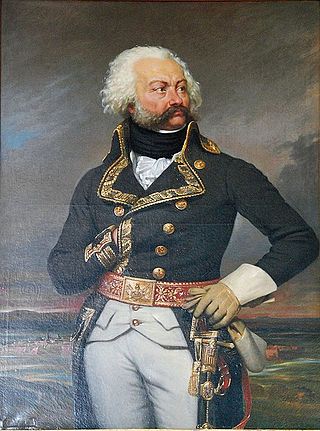
The capture of Porrentruy was a siege of the Swiss town of Porrentruy. The town was held by Austria and attacked by the French. The event occurred on 28 April 1792 and resulted in victory for the French forces. This engagement marked the commencement of the War of the First Coalition.
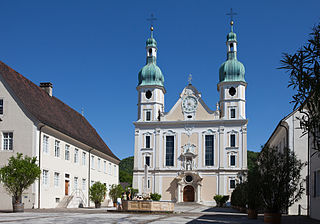
Arlesheim Cathedral is a Roman Catholic church, which now serves as the main church of Arlesheim. From 1679 to 1792 it was the church of the displaced cathedral chapter of the Diocese of Basel in the Basel-Landschaft in the northern part of Switzerland.

The Delémont–Delle railway is a standard gauge railway line in the canton of Jura and belongs to the Swiss Federal Railways (SBB).





















